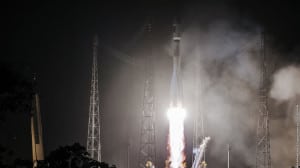Galileo to Begin Initial Service By the End of the Year
[Via Satellite 05-24-2016] The European Commission successfully launched another pair of Galileo satellites aboard an Arianespace Soyuz ST-B launch vehicle from French Guiana on May 24, marking the 13th and 14th satellites in the European Global Navigation Satellite Services (GNSS) constellation, which consists of a planned 30 satellites in total. The Soyuz launch vehicle completed a nearly 3-hour, 48-minute mission, placing the Galileo passengers into a targeted circular orbit at an altitude of 23,522 km, inclined 57.394 degrees to the equator, according to the European Space Agency (ESA). Arianespace estimated total payload lift performance at 1,599 kg.
The launch of satellites 13 and 14 is the first of two in 2016 that aim to deploy six new Galileo satellites this year, a number matching that deployed in 2015 and bringing the total number in the constellation to 18 by the end of the year.
Once all 14 satellites currently in orbit reach Full Operational Capability (FOC), Paul Verhoef, director of Galileo program and navigation-related activities at ESA, said the constellation may be able to begin initial services.
“We are now at the point that we are completing the infrastructure to allow initial services to be announced later in the year by the European Commission. We would have for that 14 satellites in orbit, plus the necessary ground segment, which allows us to provide initial services,” Verhoef told journalists during a pre-launch conference call on May 23.
The EU-funded Galileo program represents Europe’s first civil GNSS and initial capability will allow users to know their exact position in time and space with increased precision and reliability. The GNSS can also deliver Search and Rescue (SAR) signals as part of the international Cospas–Sarsat System and a secure regulated service that is intended for use by law enforcement and public officials, according to Verhoef. Once complete, the system will consist of 24 operational satellites and the ground infrastructure for the provision of positioning, navigation and timing services. The complete Galileo constellation will consist of 30 satellites along three orbital planes in Medium Earth Orbit (MEO), including two spares per orbit.
The European Commission, through its contract with the European Space Agency (ESA), will continue putting space and ground segment infrastructure in place to reach FOC in 2020.
The constellation is now on track for a full deployment in 2020, having overcome a delay caused by issues with its initial satellites and a launch anomaly that placed the first pair of FOC satellites into improper orbits.
Three of the first four Galileo satellites in orbit experienced irregularities after their initial 2014 launch. Furthermore, the first pair of full satellites, the fifth and sixth satellites in the constellation, were placed in improper orbits in August 2014 by a malfunction of their Soyuz launcher’s upper stage. According to two separate independent inquiry boards established by Arianespace and Roscosmos, the anomaly that occurred 35 minutes into the launch of the Soyuz mission VS09 stemmed from frozen hydrazine chilled by its proximity to cold helium feed lines within the Soyuz rocket’s Fregat upper stage. The frozen lines caused two attitude control thrusters to fail, resulting in subsequent inertial system behavior that left two uninsured Galileo navigation satellites in unintended orbits.
The satellites’ shifting altitude left them unable to lock onto Earth for part of each orbit, preventing them from being used for navigation purposes. The elongated orbits have since been modified so that the navigation payloads can perform as planned.
Going forward, the European Commission plans to launch the remaining satellites with Ariane 5 heavy lift launch vehicles, one in each of the orbital planes. The next Ariane 5 launch is scheduled for November 17.
“As far as deployment is concerned, we had six satellites launched last year. We will launch six this year. We will launch four next year and four in 2018. That brings us to 26 satellites by 2018, and already beyond the operational constellation of 24. We will be launching some spares after that,” said Verhoef.
Surrey Satellite Technology Ltd (SSTL) is responsible for building the satellite payloads. Earlier this month SSTL delivered the 22nd Galileo navigation payload, the last under Galileo Full FOC Work Orders 1 and 2, to prime contractor OHB System in Bremen, Germany, which is responsible for platforms and overall integration.
According to Verhoef, the European Commission has begun open procurement for further satellites, which will likely be contracted by the end of the year, after which the agency will begin procuring launchers for the third batch of satellite launches.
